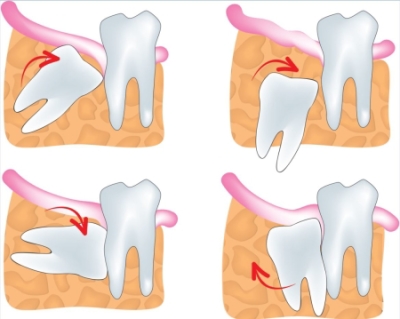What are Wisdom Teeth?
Wisdom teeth are the teeth that come in as the third molars in a person’s mouth. They are extremely difficult to clean because of their placement inside the mouth. They can cause serious pain and swelling which lead to gum disease. Not all wisdom teeth fully erupt. Many people have to deal with partially erupted teeth that only display half of the top surface or less.
Most toothbrushes cannot touch the wisdom teeth even when they fully erupt. Because of the difficulty brushing the teeth, wisdom teeth almost always become infected and start to decay. When they decay, they can cause pain, facial swelling and unnecessary discomfort. This can also happen to other teeth which is a common reason for tooth extraction.
Our dentists will offer to perform a wisdom tooth extraction instead of trying to place a filling on such a tooth since the person will not lose any chewing or speaking ability by the loss. A wisdom tooth extraction consists of an anesthetic and the vigorous efforts of a dentist. Sometimes, dentists have to cut the gum to reach an impacted tooth. Discover wisdom teeth removal near me
The California Dental Association states: “Regular dental visits are an important part of keeping your wisdom teeth healthy and stable.”


A Wise Surgical Procedure: Wisdom Teeth Extraction
Wisdom teeth (the third molars) cause problems for many people. They may have to be removed if they cause gum inflammation, infection, tooth or jaw pain, or crowding of front teeth.
Removing wisdom teeth preventively can remove the potential of encountering complications such as decay or injury to adjacent or missing teeth in the future. Your teeth will be X-rayed to examine the tooth roots. You will receive local anesthesia to numb your gums, but will otherwise be awake during the procedure. You may request or the dentist or oral surgeon may recommend sedation to relax you.
Contact us for the cost of wisdom teeth removal near Fullerton or to find out if your dental insurance covers your extraction.
For the procedure, specialized extraction instruments are used, depending on the type of impaction (soft gum or bone tissue) and the tooth’s position (angled under gum or partially exposed).
- A small incision is made in the gum, and the gum tissue is moved to the side.
- Any bone covering the tooth is cut away and removed.
- The tooth may be sectioned into smaller parts to make it easier to remove through the small incision.
- The tooth is removed.
- The site is cleaned and irrigated of debris; stitches may be used to close the gum.
- Gauze is placed over the extraction site and you’ll be asked to bite down on it.
- The firm pressure will allow a blood clot to form, allowing the wound to heal from the inside out.
- It is important to eat soft foods after the procedure. The less chewing the better for faster recovery
- Oral hygiene is important to prevent dry sockets.
- You’ll be given detailed postoperative instructions to follow treatment.
Make an appointment with our Oral Surgeon, Dr. Andrew Lee, DDS if you’re near Fullerton, CA. If you have any questions regarding insurance, give us a call.
Wisdom Tooth Removal FAQs
The healing time for a wisdom teeth extraction surgery varies depending on what kind of sedation you had, if any, and whether the surgeon needed to cut through skin or bone to remove the teeth. Some people are able to resume normal activities the same day, while others will need to take it easy for several days. Healing should be complete within a couple weeks at the longest. Schedule an appointment wit us today if you’re near Fullerton CA.
Because your body considers a wisdom teeth removal to be a traumatic event, it tries to heal the area as soon as possible. As strange as it sounds, inflammation and swelling actually help the healing process. However, not everyone gets swollen, and some get swollen more than others.
Some people choose to remove all four wisdom teeth whether or not they are visibly impacted, just in case damage occurs later.
It depends on your insurance. Talk with both your health care and dental insurance providers and find out exactly what is covered and how much. Wisdom teeth removal is under the heading of “oral surgery.”
An oral surgeon or dentist will make a small incision into the gum area and pull out what is visible from there. If necessary, he or she will remove part of the bone surrounding the broken tooth. X-rays are taken of your mouth before the surgery, so the surgeon knows exactly how many pieces to look for and remove, and where to find them. Set up an appointment with our office today if you’re near Fullerton.
Depending on your individual situation, such as how impacted or broken your wisdom teeth are, the extraction could take anything from thirty minutes to several hours. Recovery time also depends on how the person reacts to anesthesia, among other factors.
Because the wisdom teeth removal procedure is a surgery and requires cutting into your gums, pain is to be expected. If necessary, pain medication can be prescribed for the first few days. After then you may still experience pain from food touching the inside part where your wisdom teeth used to be until your body heals that space by sealing it up.
